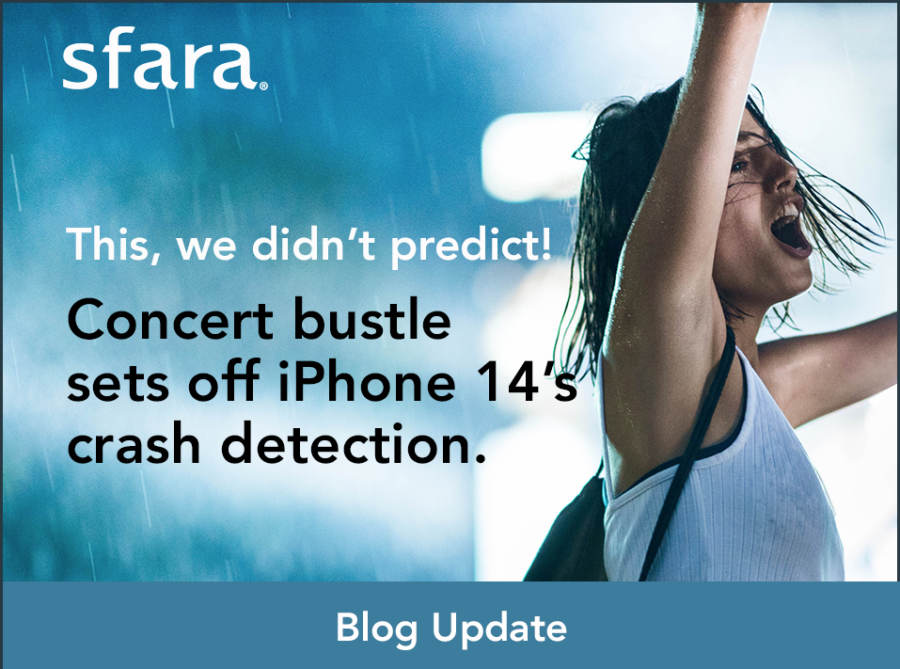We’ve written two previous blogs about issues surrounding Apple’s crash detection service, which they introduced into their watches and the iPhone 14 last Fall. The issues stem mainly from the generation of false positive crash events.
Here is an excerpt:
Online and media sources are heavily reporting that the iPhone 14 is generating large numbers of false positive crash events (crashes that aren’t crashes). These detections are causing the phones to contact emergency response centers about non-existent emergencies, flooding already stressed dispatch and emergency services.
This was happening during the winter months on ski slopes, where skiers were simply skiing, but their routine impacts were setting off Apple’s crash detection service.
We went on to write:
In a few months, the problem will move from the ski slopes to golf courses (golf carts) or amusement parks (roller coasters). Sooner or later, this will turn into a serious issue, as dispatchers in more varied locations get bogged down responding to non-emergencies.
Well, now that outdoor concert season has arrived, we’re seeing a new source of false positive detections, some in completely unexpected and, as of yet, inexplicable ways, such as what is happening at the mega music festival “Bonnaroo” in Tennessee.
This past weekend, police from the local area have reported receiving multiple false emergency calls from concert attendees, resulting in response confusion and overload. Although there is not yet a definitive reason, many suspect the false detections are a result of behavior in the mosh pit. We have to admit, we didn’t predict this one. In fact, we’re a bit baffled by it.
Usually crash detection services are activated (turned on) when the phone’s sensors detect a “trip start,” which means that the phone detects consistent-enough movement and momentum to “know” that the phone is moving in a vehicle. Without an accurate trip start detection, the crash detection service would run continuously, causing many issues, including the ones that are happening at Bonnaroo. To us, it is inconceivable that any crash detection service would not have a reliable trip start and validation service to activate it.
These false emergencies are being reported because of outdated technologies and methodologies still being used for crash detection, often without a second layer specifically focused on eliminating false positive detection. [At Sfara, we have our Integrated Suppression Framework.]
Journalists and bloggers are quick to find humor in this Bonnaroo story. They comment that with hard-driving musical acts such as Foo Fighters, Lil Nas X, Pixies, Kendrick Lamar and Korn, there was bound to be hard-knocking energy forces at work.
And yes. We agree. There would be humor in the situation if the consequences weren’t so serious. There is no argument against it: False positive crash detections cause phones to contact emergency response centers about non-existent emergencies, when resources are already stretched thin to handle real ones.
Luckily, this is still a relatively isolated problem. The 14 still has limited market share. But as companies continue to integrate inferior crash detection services into new devices, this is going to get worse and worse.
We can’t close with a better ending than expressed in our previous blog:
This is a case where the industry must take a stand, by rejecting and replacing existing, outdated crash detection solutions, as they are putting undue pressure on our emergency response system, putting lives at risk, and diminishing the possibility of a quick and early adoption by the wider marketplace.
Check out our previous blogs on this topic:
Top three reasons why Apple’s crash detection obviously wasn’t intended for enterprise programs
This blog highlights why Apple’s crash detection shouldn’t be used for enterprise programs and the considerations and technologies necessary for a successful program. If you want to ensure your program doesn’t suffer from similar issues as the iPhone 14, this is the blog to read.
https://www.sfara.com/top-three-reasons-why-apples-crash-detection-obviously-wasnt-intended-for-enterprise-programs/
Apple’s iPhone 14 exposes weaknesses of market’s existing crash detection services (Sfara calls for the industry to act responsibly)
This blog highlights and explores real-world scenarios in which the crash detection service is causing problems for local emergency dispatchers.
https://www.sfara.com/apples-iphone14-exposes-weaknesses-of-markets-inferior-crash-detection-services-sfara-calls-for-the-industry-to-act-responsibly/
Links to industry news reporting the Bonnaroo situation:
Loudwire
https://loudwire.com/bonnaroo-festival-goers-making-accidental-911-calls-iphone-crash-feature/
NME
https://www.nme.com/news/music/new-iphone-feature-causes-accidental-911-calls-at-bonnaroo-3458026

